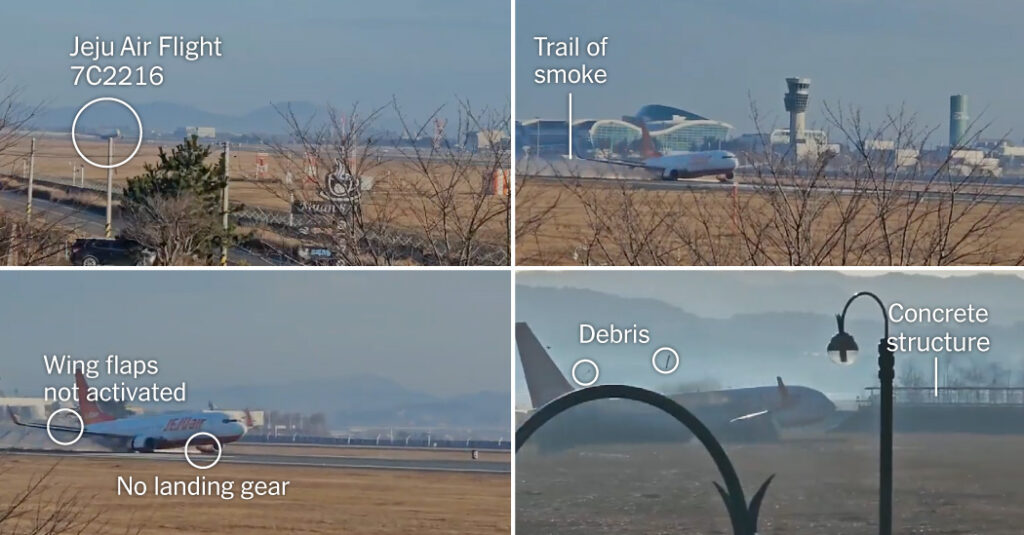All however two of the 181 individuals aboard a passenger aircraft in South Korea had been killed on Sunday morning, within the deadliest world aviation catastrophe in years.
Days after the Jeju Air crash, there’s little clarification about why the aircraft went down. As investigators attempt to piece collectively what occurred, video from the scene and early official reviews supply clues.
The pilot reported a chook strike at 8:59 a.m. and instructed air site visitors controllers at Muan Worldwide Airport that he would abort his touchdown try and circle within the air to organize for one more one. As an alternative of going all the best way round, he approached the runway going through south at excessive velocity.
The aircraft missed the standard landing zone and landed a lot farther alongside the runway than regular. It then hurtled down the touchdown strip on its stomach, leaving a path of smoke.
The pilot appeared unable to regulate the engines and no touchdown gear was seen because the aircraft made contact with the runway — two vital components in slowing a aircraft down throughout touchdown. The aircraft additionally didn’t seem to have activated its wing flaps, one other technique of controlling velocity.
The aircraft ultimately overshot the runway and crashed right into a concrete construction.
On the finish of the video, the aircraft had burst into flames.
The plane was a Boeing 737-800 jet, probably the most widespread passenger planes on the earth. It had taken off from Bangkok with six crew members and 175 passengers, most of whom had been South Koreans returning residence after a Christmas trip in Thailand.
Officers recovered the aircraft’s “black field,” an digital flight recorder that incorporates cockpit voice and different flight knowledge that assist investigations of aviation crashes.
The gadget was partly broken, so it might take time to get well the information, in keeping with consultants, however it might show essential in figuring out what occurred within the four fateful minutes between when the pilot reported a chook strike and when the aircraft crashed.
Sources: South Korean transport ministry; satellite tv for pc picture by Maxar Applied sciences
Aviation analysts are contemplating a number of components which may have contributed to the crash, including the concrete structure close to the runway that the airline slammed into earlier than exploding right into a fireball.
Comparable concrete buildings exist in different airports in South Korea and overseas, mentioned Ju Jong-wan, a director of aviation coverage on the Ministry of Land, Infrastructure and Transport. It was constructed in keeping with rules however the authorities deliberate to analyze whether or not the foundations ought to be revised within the wake of the Jeju Air crash, he mentioned.
Photograph by Chang W. Lee/The New York Occasions
A satellite tv for pc picture captured on Monday confirmed dozens of autos on the website of the wreckage. The work of piecing together hundreds of body parts has been painstaking, however the authorities mentioned that by Tuesday morning, 170 our bodies had been recognized and 4 had been turned over to their households.
Supply: Satellite tv for pc picture by Planet Labs on Dec. 30
The crash was the deadliest worldwide since 2018, in keeping with the United Nations, when Lion Air Flight 610 crashed off the coast of Indonesia, killing all 189 individuals on board.

